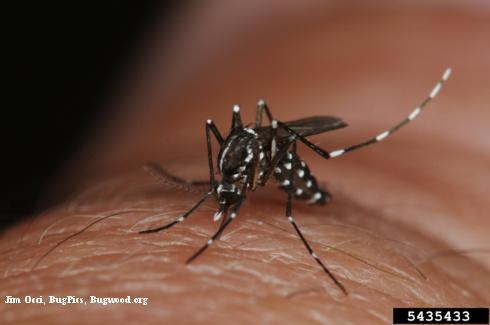Aedes mosquitoes can transmit some of the most debilitating and deadly mosquito-borne pathogens to humans, such as Zika virus, dengue virus, chikungunya virus, and yellow fever virus. One Aedes species is also capable of transmitting heartworm to dogs. These invasive mosquitoes are now present in many regions of California, from Shasta County to San Diego County. View a map of Aedes distribution by county.

The yellow fever mosquito (Aedes aegypti), the Asian tiger mosquito (Aedes albopictus), and the Australian backyard mosquito (Aedes notoscriptus) are unlike most native mosquitoes. They prefer to bite during the day, especially around your legs and ankles. Adults are black with white stripes on their legs and back.
Many Aedes mosquitoes live in close contact with people and can breed in backyards and even inside homes. They are known as “container breeding mosquitoes” because they lay eggs in small containers, such as flowerpots or old tires. Eggs are laid in moist areas just above the water surface, can overwinter, and are resistant to drying so may remain viable for months or longer. Their entire life cycle can occur in as little as 7–8 days.
What can you do?
In many areas of California, public Mosquito and Vector Control Districts work to keep mosquito numbers down to tolerable levels. Since these mosquitoes primarily breed on residential properties, you can help by eliminating mosquito breeding sources around your home. This includes draining standing water in rain gutters, buckets, and watering cans. Change the water in pet dishes and bird baths weekly. Clean up clutter in the yard since these mosquitoes can lay their eggs in anything that can hold water. Standing water or ponds can be treated with Bacillus thuringiensis subspecies israelensis (Bti) or mosquito fish. Wear mosquito repellents and protective clothing outdoors. Keep mosquitoes out of your home by keeping fine mesh screens on windows and doors in good condition.
Learn more about invasive Aedes mosquitoes and how to protect yourself by visiting the following resources:
- UC IPM Pest Notes: Mosquitoes: https://ipm.ucanr.edu/PMG/PESTNOTES/pn7451.html
- Mosquito repellent information from the California Department of Public Health: https://www.cdph.ca.gov/Programs/CID/DCDC/Pages/Mosquito-Repellent.aspx
- Interactive map of Aedes distribution in California: https://cdphdata.maps.arcgis.com/apps/webappviewer/index.html?id=57367199287a4d18a2cecf107854255b
- Invasive Aedes fact sheet from the Mosquito and Vector Control Association of California: https://acrobat.adobe.com/id/urn:aaid:sc:US:908f4b9e-8266-47b3-9e3d-ec165913fc7f?viewer%21megaVerb=group-discover
[Featured in the Summer 2024 edition of the Home and Garden Pest Newsletter]